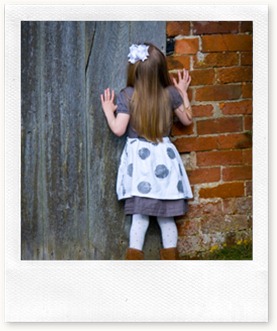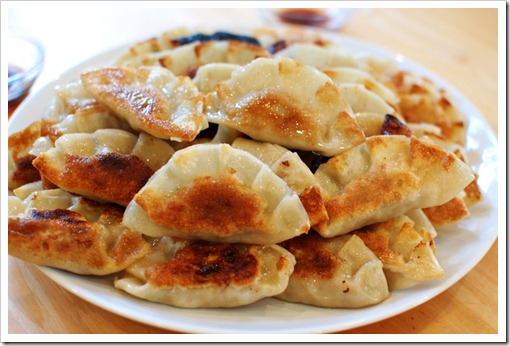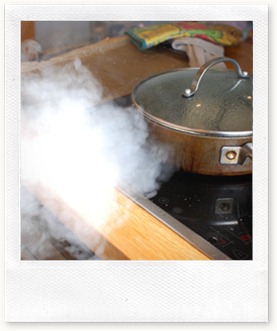Fri 24 Sep 2010
Savouring Childhood Memories
Posted by Clare under Irish food, Irish small town, Main Course, Recipes
[10] Comments
 The other day while out to eat with my friends we got into a discussion about colcannon, the much-beloved traditional Irish dish of mashed potatoes and cabbage, spring onions or kale, depending on how your mam prefers to make it. Sinead and Earnan recalled how as kids, they always had a very specific way of eating their colcannon. They and their siblings would create a little volcano with the potato mixture and then put a lump of butter in the middle, resulting in a butterlicious lava flow that churned out from the center of the mash mountain. No one remembers who started the trend but they both recalled with great affection this small but crucial colcannon custom.
The other day while out to eat with my friends we got into a discussion about colcannon, the much-beloved traditional Irish dish of mashed potatoes and cabbage, spring onions or kale, depending on how your mam prefers to make it. Sinead and Earnan recalled how as kids, they always had a very specific way of eating their colcannon. They and their siblings would create a little volcano with the potato mixture and then put a lump of butter in the middle, resulting in a butterlicious lava flow that churned out from the center of the mash mountain. No one remembers who started the trend but they both recalled with great affection this small but crucial colcannon custom.
I am always impressed at how close my Irish friends keep their childhood memories; whether we’re drinking at the pub or taking a spin around town, the entertainment is often tales from their childhood, always told with smiling eyes and a kind of pure giddiness that’s usually limited to children themselves.
Most of my friends here grew up in the country, so theirs was a childhood of wild adventures created on even wilder imaginations. They didn’t have the constant distraction of video games or Barbie’s new summer line. Many shared their bedrooms, toys and clothes with at least a few siblings. Their main job, besides helping with a handful of chores around the house, was to stay out of the way, because the adults had plenty to keep themselves occupied what with keeping food on the table for a half-dozen kids and a roof over those little buggers’ heads. There was plenty of mischief; Sinead recalls the time her cousin Barry playfully tied her and their other cousin Ciara to a fence and then got a gang of other cousins to come over and make fun as the two girls tried in vain to free themselves. That one kept the whole lot entertained for at least a few hours.
My childhood in Los Angeles was very different. It was just my sister and me, as our cousins all lived several states away. And being constantly exposed to a barrage of flashy distractions like MTV, motorized kids’ cars and enormous backyard swimming pools at friends’ houses (our parents wouldn’t allow such things at home) didn’t exactly inspire us to be creative with our free time. Don’t get me wrong; my parents tried in vain to emphasize the joys of simple, childhood activities and though we’d show an initial interest, our friends’ shiny toys and the desire for such things would win out every time. I remember one summer my father gave me a book on string art, and I did make a couple of pieces: one was a big, brown mushroom and the other was a sign for our window that said, “The Kleinedlers.” I sanded and stained the pieces of wood, hammered in the nails and carefully strung the yarn myself (though half-way through working on the second piece I was cursing my long last name). It was satisfying, I learned something new and I had a tangible result from my efforts, but I’m pretty sure I went right back to pining away for cable television shortly after I completed the projects.
But one of the activities I thoroughly enjoyed as a child was cooking, and though my parents included it in our list of chores I never saw it as work. Whether it was rinsing frozen peas for my dad’s famous tuna casserole or whipping egg whites with our little hand-held mixer, I loved every minute of the process and many of my happy childhood memories revolve around the kitchen. Whenever my mother made gyoza, a type of pan-fried, Japanese potsticker, it was my duty to sit and help her fill and fold the little dumplings. I’d take one of the round wonton skins in my hand, place about a teaspoon of pork/shrimp filling in the middle, dip my finger in a bowl of water and drag it across one side of the wonton skin and then gently fold and seal the gyoza. I would then take two fingers and create little scallops around the top. After we finished my mother would cover the whole platter of freshly-made gyoza with a damp cloth to keep them from drying out. When she wasn’t looking, I’d peel back the cloth and marvel at all at those perfect little gyozas with their perfect little creases. Maybe it was the anticipation of eating the gyoza or the pride I felt for helping create them, but I’d sneak a peek under the cloth a half-dozen times before my mom took them to the stove to cook.
Pork and Shrimp Gyoza
(Makes about 55 gyoza)1/2 pound raw minced pork
3/4 pound raw prawns, peeled and deveined
1 large tablespoon grated ginger
1 large tablespoon minced garlic
1 cup finely diced cabbage
3 spring onions, sliced thin, white and green parts
1 tablespoon soy sauce
1 teaspoon dark toasted sesame oil
2 teaspoons corn starch or potato starch
2 packages of round wonton skins, also called dumpling pastry (you can get this frozen in most Asian markets). Each package usually has 40 skins.
Vegetable oil
Hot water
Soy sauce for dipping/serving
First, chop the prawns into very tiny pieces – almost like a mince. Sometimes it’s easier to use two knives for this. Set aside.
In a large bowl, combine the pork, prawns, ginger, garlic, cabbage and spring onions and mix well using a wooden spoon or clean hands. Then add in the soy sauce, sesame oil and corn starch and mix thoroughly.
To assemble, you will need a small bowl of water, a tray for the gyoza and a damp cloth to cover them with. Take one wonton skin, put about one teaspoon of the filling in the center, and then dip your finger into the water and drag it across the inner edge of one side of the wonton skin. Fold it together into a half-moon shape and make sure it is sealed (the water will act as the glue). Using two fingers create little scallops or creases and pinch. Or you can just leave the edge flat if you prefer.
To cook you will have to do this in batches, so preheat your oven to 100C as you’ll need to keep these warm after cooking: Heat up about one tablespoon of vegetable oil in a large, shallow sauté pan that has a lid. Heat the oil up on medium-high heat until it is very hot but not smoking. Carefully lay one layer of gyoza into the oil – leaving at about a ½ inch between each one. Do not move them around – this process will give one side of the gyoza a nice, golden crust. Cook for about 1-2 minutes, checking to see if a crust as formed. As soon as you see a deep, golden crust on the underside, take about ¼ cup of hot water, put it into the pan with the gyoza and immediately put the lid on the pan – be careful, the water will simmer wildy so keep the lid handy. This steaming process will cook the gyoza completely. Let steam for about 2 minutes. Remove from the pan and place on a baking tray and keep warm in the oven. Do another batch the same way, starting off with the oil (you will need to add oil every time). Serve with little dipping plates of soy sauce. I add a bit of chili oil to my dipping soy sauce but that is up to you! Enjoy!
*Photo credit of little girl: Image: Tina Phillips / FreeDigitalPhotos.net







Your friends’ story about colcannon reminds me of this old Irish song, called “Colcannon (The Skillet Pot)”:
Did you ever eat colcannon, made from lovely pickled cream?
With the greens and scallions mingled like a picture in a dream.
Did you ever make a hole on top to hold the melting flake
Of the creamy, flavoured butter that your mother used to make?
Yes you did, so you did, so did he and so did I.
And the more I think about it sure the nearer I’m to cry.
Oh, wasn’t it the happy days when troubles we had not,
And our mothers made colcannon in the little skillet pot.
Your blog is always such an enjoyable read
Only the Irish could shed a tear over potatoes;)! Just kidding, that is a very sweet song, and I’d love to have a melted butter puddle in the middle of potatoes any time.
Did you fold the gyoza by hand, or do you have a gyoza press? They look so consistent. Mine don’t look that great.
Kristin: Love those lyrics – so adorable! I will have to Google the song now. 🙂
Liam: You are so kind, I really appreciate your compliments. Thanks so much for reading the blog!
Anne: Bite your tongue!! Those are all handmade, no gyoza press here!!
you missed the part of the ring, the rag and the stick, mammy used to hide them in the colcannon and whichever you got was our destiny…I usually got the rag ( i would be poor 🙁 ) good times, i would love a colcannon volcano now..
what about a colcannon Gyoza? I was going to suggest haggis, but then I remembered that wasn’t irish…
Aine: Your mam says that’s only for Halloween colcannon, lol.
Randy: I think you are onto something there, may have to try it!
Barry was always such a gentleman 🙂
Nice one, Clare. Would love to try your recipe!
Probably good you didn’t get into the more “simple” activities when you were a kid… your parents’ house would still be full of pasta&bean collages and lamps made out of Mrs Butterworth bottles!!! I loved making stuff with my mom and grandma, too though – especially Thanksgiving and Christmas foods and sweets!
I think colcannon gyoza would technically be pierogi.